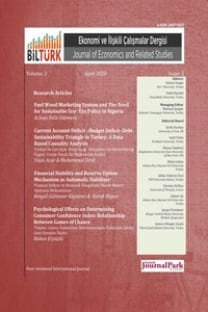Yolsuzluk ve Kamu Kesimi Büyüklüğü: Panel Nedensellik Analizi ile Bir İnceleme
Bu çalışmanın hazırlanmasındaki temel güdü ulusal ve uluslararası boyutta önemli bir gündem olan yolsuzluk ile kamu kesimi büyüklüğü arasındaki karşılıklı nedensellik ilişkisinin yönünü tespit etmektir. Bu çerçevede 1996-2021 yılları arasında verilerine ulaşılabilen 24 Avrupa ülkesi için yolsuzluğun kamu kesimi büyüklüğünü açıkladığı ve kamu kesimi büyüklüğünün yolsuzluğu açıkladığı 2 ayrı modelde tahminler yürütülmüştür. Sonuç olarak gerek eş bütünleşme testinde gerekse nedensellik analizinde kamu kesimi büyüklüğünden yolsuzluğa doğru bir ilişkinin olduğu gözlemlenmiştir. Diğer bir ifadeyle ilişkinin yönünün kamu kesimi büyüklüğünden yolsuzluğa doğru olduğu doğrulanmıştır. Buna karşın elde edilen bulgular neticesinde yolsuzluktan kamu kesimi büyüklüğüne doğru ne kısa dönemli ne de uzun dönemli bir ilişkinin varlığı saptanamamıştır. Bu çerçevede kamusal politikaların yönlendirilmesinde, kamu kesiminin yolsuzluklar üzerindeki belirleyiciliğini belirginleştiren bu tahmin sonuçlarının dikkate alınması önem arz etmektedir.
Anahtar Kelimeler:
Yolsuzluk, Kamu Kesimi Büyüklüğü, Panel Veri
___
- Acemoglu, D., & Verdier, T. (2000). The choice between market failures and corruption. American economic review, 91(1), 194-211.
- Alesina, A., & Angeletos, G.-M. (2005). Corruption, inequality, and fairness. Journal of Monetary Economics, 52, s. 1227–1244.
- Arvate, P. R., Curi, A., & Rocha , F. (2010). Corruption and the size of government: causality tests for OECD and Latin American countries. Applied Economics Letters, 17(10).
- Bel, G. (2022). Beyond government size: Types of government intervention and corruption. Regulation & Governance, 16(4), s. 1174-1196.
- Bird, R. M., Martinez-Vazquez, J., & Torgler, B. (2006). Societal institutions and tax effort in developing countries. The challenges of tax reform in a global economy, 283.
- Billger, S. M., & Goel , R. (2009). Do existing corruption levels matter in controlling corruption? Cross-country quantile regression estimates. Journal of Development Economics, 90, s. 299–305.
- Dreher, A., & Schneider, F. (2006). Corruption and the shadow economy: an empirical analysis. CESifo Working Paper No. 1653.
- Dumitrescu, E. I. & Hurlin, C. (2012). Testing for Granger non-causality in heterogeneous panels. Economic Modelling, 29(4), 1450-1460.
- Elliott, K. A. (2017). Corruption as an international policy problem. In Political Corruption (pp. 925-942). Routledge.
- Enste, D. H., & Heldman, C. (2017). Causes and consequences of corruption: An overview of empirical results. 4 30, 2023 tarihinde https://www.econstor.eu/bitstream/10419/157204/1/IW-Report-2017-02.pdf adresinden alındı
- Goel, R. K., & Budak , J. (2006). Corruption in transition economies: Effects of government size, country size and economic reforms. Journal of Economics and Finance, 30(2), s. 240-250.
- Goel, R. K., & Nelson , M. (1998). Corruption and government size: A disaggregated analysis. Public Choice, 97, s. 107–120.
- Goel, R. K., & Nelson, M. (2010). Causes of Corruption: History, Geography and Government. Journal of Policy Modeling, 32, 433–447.
- Gupta, S., Davoodi, H., & Alonso-Terme, R. (1998). Does Corruption Affect Income Inequality and Poverty? IMF Working Paper.
- Güran, M. C. (2001). Etkin Devlet ve Türkiye. H.Ü. İktisadi ve İdari Bilimler Fakültesi Dergisi, 19(1), 199-218.
- Gwartney, J., Lawson, R., ve Holcombe, R. (1998). The size and functions of government and economic growth. Washington: Joint Economic Committee, 1-32.
- IMF. (2021). World Economic Outlook Database. Erişim 30 Nisan 2023, https://www.imf.org/en/Publications/WEO/weo-database/2021/April/download-entire-database
- Kotera, G., Okada, K., & Samreth, S. (2010). A study on the relationship between corruption and government size: the role of democracy. Munich Personal RePEc Archive, s. 1-19.
- Kotera, G., Okada, K., & Samreth, S. (2012). Government size democracy and corruption: An empirical investigation. Economic Modelling, 29(6), s. 2340–2348.
- Krueger, A. O. (1974). The political economy of the rent-seeking society. The American economic review, 64(3), 291-303.
- La Porta, R., Lopez-de-Silanes, F., Shleifer, A., & Vishny, R. (1999). The quality of government. 15(1), s. 222–279.
- Niskanen, W.A. (1971) Bureaucracy and Representative Government. Chicago: Aldine-Atherton.
- Ondo, A. (2017). Corruption and Economic Growth: The Case of EMCCA. Theoretical Economics Letters, s. 1292-1305.
- Ott, J. (2018). Measuring economic freedom: Better without size of government. Social Indicators Research, 135(2), 479-498.
- Pesaran M. H. (2004). General diagnostic tests for cross section dependence in panels. IZA Discussion Paper Series, No: 1240.
- Pesaran M. H. (2007). A simple panel unit root test in the presence of cross-section dependence. Journal of Applied Econometrics, 22, 265-312.
- Persson, A., & Rothstein, B. (2015). It's my money: Why big government may be good government. Comparative Politics, 47(2), s. 231–249.
- Rothstein B, Teorell JA (2008) What Is Quality of Government? A Theory of Impartial Government Institutions. Governance 21(2), 165–190.
- Schneider, F. (2006), “Shadow Economies and Corruption All Over the World: What Do We Really Know?”, Discussion Paper No. 231.
- Schneider, F., Buehn, A., & Montenegro, C. E. (2010). Policy Research Working Paper 5356. Policy. Shleifer, A., & Vishny, R. (1993). Corruption. The Quarterly Journal of Economics, 108(3), 599–617. doi:https://doi.org/10.2307/2118402
- Themudo, N. S. (2014). Government Size, Nonprofit Sector Strength, and Corruption: A Cross-National Examination. American Review of Public Administration, 44(3), s. 309–323.
- Torgler, B. & F. Schneider (2007), “Shadow Economy, Tax Morale,Governance And Institutional Quality: A Panel Analysis”, CESifo Working Paper No. 1923.
- Tosun, U. (2001). Yolsuzluk Olgusuna Yönelik Yapılan Ampirik Çalışmalar Üzerine Notlar. H.Ü. İktisadi ve İdari Bilimler Fakültesi Dergisi, 19(2), 97-122.
- Westerlund, J. (2007). Testing for error correction in panel data. Oxford Bulletin of Economics and Statistics, 69: 709–748.
- Williams, C. C., & Schneider, F. (2013). The Shadow Economy. The Institute of Economic Affairs.
- World Bank. (2021). The Worldwide Governance Indicators. Erişim: 30 Nisan 2023, https://info.worldbank.org/governance/wgi/
- Yayın Aralığı: Yılda 4 Sayı
- Başlangıç: 2019
- Yayıncı: Fatih DEYNELİ
Sayıdaki Diğer Makaleler
Yolsuzluk ve Kamu Kesimi Büyüklüğü: Panel Nedensellik Analizi ile Bir İnceleme
Melek BİNARBAŞI, Hakkı Hakan YILMAZ
Kamu Politikaları Doğrultusunda Devlete Olan Güvenin Yaşam Kalitesi Üzerindeki Etkisi
Türkiye'de Suçun Sosyo-Ekonomik Belirleyicileri
Başak SEZGİN KIROĞLU, Şennur SEZGİN
Türkiye’de Akıllı Şehir Uygulamasına Yerel Yönetimlerin Mali Görünümü Çerçevesinde Bir Bakış
